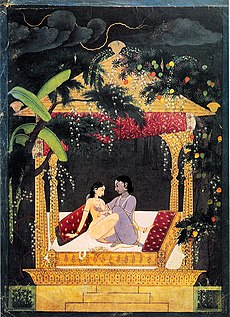Krishna and Radha in a Pavilion
Appearance
| Krishna and Radha in a Pavilion | |
|---|---|
 | |
| Artist | Unknown artist |
| Year | circa 1760 |
| Type | Opaque watercolor on paper |
| Dimensions | 28 cm × 20 cm (11 in × 7.9 in) |
| Location | National Museum, New Delhi |
Krishna and Radha in a Pavilion is an 18th-century Indian painting depicting the two Hindu deities Krishna and Radha engaged in sexual intercourse.
Description
The painting is the example of Pahari painting used in Gardner's Art Through the Ages:[1]
"In Krishna and Radha in a Pavilion, the lovers sit on a bed beneath a jeweled pavilion in a lush garden of ripe mangoes and flowering shrubs. Krishna gazes directly into Radha's face. Radha shyly averts her gaze. It is night, the time of trysts, and the dark monsoon sky momentarily lights up with a lightning flash indicating the moment's electric passion. Lightning is a standard symbol used in Rajput and Pahari miniatures to symbolize spiritual bliss and excitement."
References
- ^ Gardner's Art Through the Ages: Non-Western Perspectives (13 ed.). Cengage Learning. 2009. p. 39. ISBN 0-495-57367-1.
{{cite book}}: Cite uses deprecated parameter|authors=(help)
